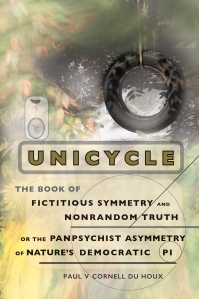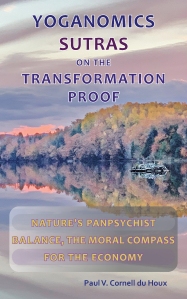Excerpt from Unicycle: Samuel’s Introduction
If nature should turn out not to respect this symmetry, then everything that we understand, our theories, and the sum of all experience would require us to go back to the drawing-board. — Frank Close, Lucifer’s Legacy: The Meaning of Asymmetry
Samuel’s Introduction
Philosophers from the earliest times have used dialogue and fictional narrative to explain themselves. There is good reason for this and specifically for attempting to find a balance between fiction and nonfiction when writing about subjects that are meant to be logical. It’s more than a question of making it interesting to the reader. It’s a question of making sense at all in the long run.
One reason for this has to do with the absence of absolutes. Such an absence is the unifying theme of these stories and essays. They are part of a common sense, logical process, proving definitively that absolutes do not exist, nor do they make sense in any language, including math.
Far from empowering our words, absolutes tend to water them down and make way for the various relativisms, which have further reduced the significance of words to a weird kind of power struggle, capable of lapsing at the state level into brute force. This book offers a fresh standard of reason to help us get beyond postmodern relativism and absolutist fundamentalism, which, while appearing to be fiercely on opposite sides of the culture wars, open back doors to each other, encouraging false choices on a road to nowhere.
What emerges from the reasoning to follow, instead of relativities and absolutes, is a balancing polarity, as in a waterfall and a millpond, where the impossibility of an absolutely flat surface on the pond above allows the water to fall onto the millwheel. This is more than a metaphor.
Why, one might ask, is it necessary for there to be no chance of an absolutely flat surface for the relationship of waterfall and pond to work? That is one of the questions — where science breaks into philosophy — addressed here in fiction and nonfiction.
Looking into the factual presence of a pond, and then into the poetic world of metaphor reflected there, one might ask, is there such a thing as absolute fiction, disconnected from the facts? The very question itself, presented to the imagination by the stories implicit in the shadows and lights of the pond, is one of nonfiction.
What about absolute nonfiction? Just the facts? Pure reason? A waterfall with no history that is open to interpretation? Just the falling water — particles of physics — with no chance of inspiring the imagination? Empirical evidence completely cut off from a consciousness that might wander and ask questions?
Using fiction and nonfiction, we will see how they are inextricably linked and must both be used in some way in order to prove the connections specifically, giving us a useful sense of direction. We will explore how logic, as a language including math, becomes hopelessly paradoxical in the absence of fiction. And that fiction cannot leave reason behind.
We will see that it is enough to be sufficiently logical for the purpose at hand, but only when leaving open the door to a magic garden with a light shinning through. This will be shown using a logical key to the nature of change; we have called it the Transformation Proof. It is a proof by contradiction, where a fiction is used to highlight the reality. The reasoning is assisted in this case by the fiction, so it does not become fiction itself. The logic is reinforced. They interact and, as may be the case when one has a story, truth is carried along in the telling. Our logic assures us that we can leave no story entirely alone.
The maze of short stories and essays that combine to form this book will demonstrate that as long as she can stop short of absolutes and universals, Nature can achieve her extreme degrees of specificity—and true power. As members of the natural world, for us to fail to do likewise is not only self-defeating but imprecise. We can share in the source of Nature’s truth in our words by abandoning the assumption that we can achieve absolutes or that they even exist, except in myth and fiction. This is not a reduction of possibilities, but an augmentation, a step on the way beyond supposed absolute limits.
In the process of reading our reports, mythical and factual, we hope you will find that the theoretical concept of the absence of absolutes has an important connection to everyday life. The collection of fiction and nonfiction together will demonstrate that we need both in order to solve some of the oldest puzzles. In particular, the Transformation Proof will be applied to the question of whether anything is absolutely random—of importance not only to probability and statistics and the evolution debate, but to the question of whether there is a basic, moral direction in life, a truth to be followed. And is that truth democratic?
Then there is the question of whether anything, including an absolute god, can be beyond everything and in some way unknowable. Alice has the answer, with a new and definitive disproving of God while deducing in the same breath the existence of soul. Witnessing this feat of unravelling the logic of change expressed in the Transformation Proof, the authors of this book were finally able to organize their project.
Key to the discovery of any fundamentally democratic sense of direction in nature is the question of absolute symmetry itself, of importance also to our everyday sense of beauty, truth, and proportion, as well as being of concern in physics, astronomy, and math.
Here we will be distinguishing between an absolute and something that is just about absolute — such as the difference between absolute symmetry and other uses of the word “symmetry.” This is more than a quibble. We will explore reasoning that shows that the difference is one of all or nothing, where to assume the absolute is to assume away everything.
Going beyond absolutes, we will explore infinity in a new way, demonstrating that the absence of absolutes rounds off infinity or “flattens” it to a specific but changing degree.
Among our conclusions we will briefly address a core issue of economics to demonstrate the ethical existence of “adverse demand” and that the value of one’s currency and the health of the economy are dependent on investing in the equal opportunity of one’s fellow human beings and in the natural environment.
Not surprisingly, when deciding on the presence or absence of something as fundamental as an absolute, we can say something about the fundamentals of any field where the qualifier of “absolute” might make a difference. Arriving in this way at the tangle of relativistic thinking that bedevils the foundations of every field — when you get down to underlying philosophy — by clearing away absolutism, we can avoid some confusion arising from the dependency between relativism and absolutism, a dependency that shows up even in the more subtle arguments of the relativists. One result will be that when we hear the word “absolute,” we can listen for the relativistic echoes associated with it and find a way through with a better sense of direction.
We will not be traveling every river in every region of philosophy, down every forest path and canoe carry into the backcountry, however compelling the view. Some fiction will be provided instead, and some essays on how this philosophy relates to some key aspects of the current mixed-up state of philosophical affairs, one that has weakened — even with the best of intentions — the legacy of the Enlightenment.
Clearly I am stirring the pot with this introduction. This book is only meant to be a preliminary report on one of the first turns in the process of stirring up a subject that should become even more relevant, in as wide a variety of ways as can be connected by thinking asymmetrically — that is, where nothing is absolutely final and everything is connected, not in every way, but in specific and characteristic ways that are often repeated but never absolutely exactly. So even though we will only touch on a range of subjects, we will have to be sufficiently specific to make contact between them at such a fundamental level.
The relevance of asymmetry is one of survival — if to think symmetrically in absolutes is to invite destruction in ways large and small. Indeed, the Transformation Proof demonstrates why true symmetry and asymmetry are mutually exclusive. So the question of personal balance arises as well; balance in the absence of absolutes brings along its own ethics to bridge the ancient divide between what is and what ought to be, a disconnect that has been considered by many thinkers to be absolute. We will discover that absolutes, while haunting relativism as effectively as they bolster absolutism (or objectivism), allow for the randomizing attitude that “anything goes” while usurping a better understanding of true balance.
One of the main problems for humans in attempting to find a standard of behavior is the question of how to find even a shred of ground outside one’s subjective consciousness — some locale like the one Plato hoped for “outside the cave,” where the view would qualify as “objective” and worthy of respect as being true. Although Plato framed the question in absolute terms, there is a tremendous amount of sympathy for this quest throughout the ages. We will reframe the question, not as one of being inside and then outside a cave of illusion, but rather of “waterfall and pond,” where a “river of asymmetry” can be deduced, one that speaks to us from within our skins of places beyond.
In this process of unfolding an idea asymmetrically — not being one that is approached absolutely directly, but in a more roundabout, natural manner — the first story we would like to introduce is the generic maze tale. As one reads a maze tale, one tends to identify with the ways it can be translated and resonates with one’s own experience. The basic structure of the ups and downs of life is clearly present. But there is an endless variety of possible experiences to be had along these well-worn pathways. The following trek is extremely spare and based on a typical design found on ancient coins from the island of Crete.
One of the most universal symbols on Earth, mazes, including labyrinths and spirals, appear on standing stones of megalithic sites such as Newgrange in Ireland, on the floors of cathedrals such as the one at Chartres in France, and Native American art. Mathematicians express them as fractals. Their intrinsic asymmetry allows for feedback and cybernetic liveliness. The continuity of these designs over time, like eddies in the river, reflects a diversity of ideas, many of which are lost, but which have carried forward a basic structure with an opportunity for more applications of new ideas. We will carry on with this theme of the maze, with gratitude for a tradition that allows us, even in spite of itself, to embark on an ever-changing adventure.



